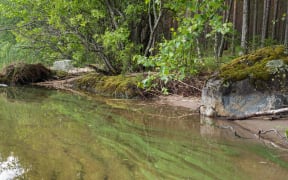Despite years of efforts to clean up South Canterbury's Wainono Lagoon, it has now been declared too toxic to swim in or fish.

Canterbury Regional Council biodiversity officer Kennedy Lange at Wainono Lagoon. Photo: Supplied
Algae planktonic cyanobacteria has been discovered for the first time at the lagoon, giving it a green tinge and prompting a public health warning.
Contact with the lagoon and the algae growing in it could cause nausea, stomach cramps, and tingling around the lips and fingers.
People and their dogs are being asked to stay out of it.
Canterbury Regional Council scientist Graeme Clarke said they would be upping their testing of it from three monthly to every week, while they tried to work out why the toxic algae was growing there.
There was already a green tinge to the water which could get brighter in the coming weeks, he said.
"They can produce some fairly significant blooms at times if they start smothering the surface of the water and can block out the light to some of the plants that are established in the lake."
The algae did not normally appear until later in summer and had never appeared in the lagoon before.
"It is a bit of a mystery but ultimately it's still a very enriched system so it's not a surprise that we're seeing it," Clarke said.
The 480ha saltmarsh is considered internationally significant and is home to 60 different bird species.
But in 2010 it was declared to be one of the country's five most degraded lakes, due to years of phosphorous and nitrogen being washed in to it from 130 surrounding farms.
Canterbury Regional Council biodiversity officer Kennedy Lange said for close to a decade, they had been working with farmers on keeping polluting sediment out of the lagoon, with the help of a $2.5 million fund.
"Actions like reducing the erosion when you get rainful events, reducing soil runoff from paddocks and improving vegetation buffers around waterways."
New planning rules that came in to force in 2017 also limited the amount of fertiliser farmers could use and the number of animals they could have on their paddocks.
However, Lange said the benefits of these changes would not be seen for many decades.
"While we are seeing some positive indicators and a trajectory of improvement, you are going to see data points on either side of that line of improvement."
Waterways on Colin Hurst's farm ran in to the lagoon. He is a member of the Waihao Wainono Catchment Group, made up of local farmers, which has been leading the charge on improving water quality.
Hurst said things were really starting to look up in the lagoon.
"We've seen the macrophytes come back, and that's an aquatic plant," he said.
"So one of the issues in the lagoon is, over the years, there's a lot of sediment built up in there. And every time there's a bit of a storm ... it stirs all the sediment and the phosphate that is tied up in the sediment as well. So with having the macrophytes getting established, the roots bind the sediment."
Hurst said while nitrogen fertiliser was definitely overused in the past and contributed to the degradation of the lagoon, its use in the last 15 years had fallen dramatically.
He gave the example of grass seed growers who had cut its use by 41 percent compared with 30 years ago, through the smarter application of it.


